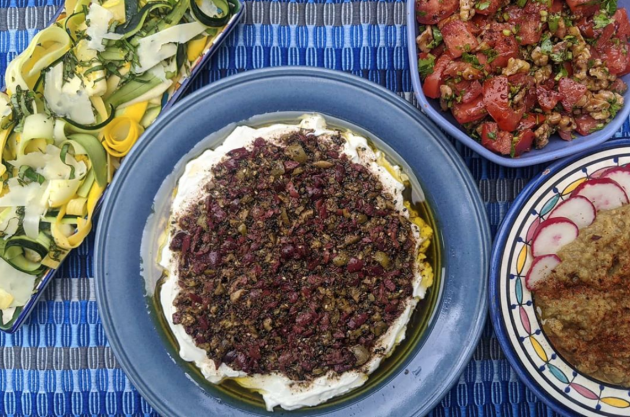
Making a Feast of Mezze
As a writer, cook, filmmaker and travel enthusiast, I’ve loved eating my way through cuisines. Many of my favorite dishes have been part of mezze, an abun- dance of cold and hot plates full of flavor and a wide variety of ingredients.
The mezze of the Mediterranean and Middle East, called salatim in Israel and tapas in Spain, are traditionally a prelude to stimulate the appetite for the main meal to follow. But for me, mezze is a wonderfully social, leisurely way to eat the meal itself. Whether dishes are brought out one by one–cold first and then hot, as is traditional–or served all at once, Mezze encourages tasting, talking and slowing down.
Mezze has a long history as part of Jewish cuisine. The exact origins of mezze are not clear, but by the Middle Ages, there are records of a variety of small plates served to guests before a bigger meal throughout the Middle East, Mediterranean and among the Sephardim and Muslims of Iberia.
As with so much of the food of the original Sephardim, we know about mezze because of Inquisition testimony, including one woman whose maid reported to the authorities that her mistress served small dishes of cold foods to her women friends who came to visit on Saturday afternoons. This was damning proof that the hostess was keeping Shabbat.
Tapas grew out of the small-plate tradition of the Jews and Muslims in Spain. They were named for the lids that would cover the dishes as they were carried from the kitchen. Tapas were originally presented at pubs, especially to men gathered on Sunday afternoons after church while the women were home taking care of the children. The tradition that many tapas include pork developed as a way to ensure everyone’s Christian faith.
Turkish Tomato and Walnut Salad
Although tomatoes weren’t part of Ottoman cuisine until the mid-1800s, the fruit quickly made its way into dishes like this. It might sound like a bit of an unusual combination, but this salad brings together the gentle sweetness of ripe tomatoes with the slightly smoky, crunch of toasted walnuts and the tart, unique flavor of pomegranate molasses. If you don’t have pomegranate molasses, try using a balsamic vinegar reduction. It won’t taste the same, but it will still be good.
1/2 cup walnut pieces or halves, roughly chopped 2 tablespoons olive oil
2 tablespoons pomegranate molasses
1 teaspoon sumac
1/2 teaspoon sea salt, or to taste
1/4 teaspoon ground black pepper, or to taste
2 cups chopped tomatoes (about 4 medium tomatoes), seeded and drained
1/4 cup chopped parsley, preferably flat leaf
Toast the walnuts in a dry sauté pan for 10-12 minutes, shaking the pan often, until fragrant and just starting to darken slightly. Put into a bowl or dish to cool and set aside. In a small mixing bowl, whisk together the oil, pomegranate molasses, sumac, salt and pepper. Put the walnuts, tomatoes and parsley into a mixing bowl. Pour on the dressing and toss together well. Serve immediately for the crispest nuts, although this salad is still good the next day.
Squash Ribbon Salad
This dish shines with the flavors of fresh vegetables, good olive oil, fragrant lemon and basil. I first ate it years ago in the Jewish quarter of Rome, and it wasn’t just the setting that made it taste so good. I’ve been serving it ever since for brunch, lunch, dinner, parties…and chopping up the rare leftovers into omelets and frit- tatas. There are no measurements here. This dish is best when made by instinct, taste and what you have available. Add the ingredients to your liking, which is the best way to cook anyway.
Zucchini
Yellow summer squash
Good quality extra virgin olive oil
Fresh lemon juice
Lemon zest
Basil leaves, cut into thin strips (chiffonade) Salt and pepper
Shaved parmesan
Using even pressure, run a vegetable peeler down the length of each squash, creating long ribbons. Continue all around the sides of the squash, stopping at the center seeds. (Save that for making soup stock.)
Pile the squash on a pretty serving plate, mixing colors and, if desired, curling a few ribbons more tightly for presentation. Drizzle with olive oil and some fresh lemon juice. Sprinkle with lemon zest, basil pieces, salt and pepper. Top with few pieces of shaved parmesan. Serve soon after making either cold or at room temperature.




